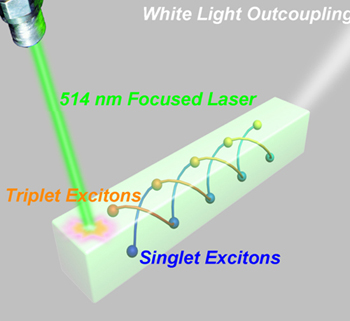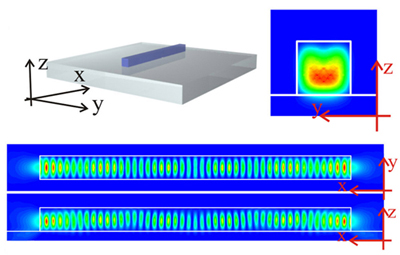Propagation and resonance of exciton polaritons in organic nanomaterials
Nano-photonics involves the study of the behaviors of photons at nanometer scale, which is potentially applied in the future information field. In organic materials, Frenkel excitons usually have a large binding energy, which can form stable exciton polaritons (EPs) with photons. This kind of strong coupling between excitons and photons plays an essential role in optical waveguiding and photoluminescence modulation in organic nanowires. In recent years, Dr. YAO Jiannian and ZHAO Yongsheng’s groups in the Key Laboratory of Photochemistry of Chinese Academy of Sciences has studied on the fabrication of organic optical waveguides and organic nanowire lasers (Adv. Mater., 2008, 20, 1661-1665; Angew. Chem. Int. Ed. 2008, 47, 7301-7305).
Recently, under the supports of the National Nature Science Foundation of China , the Chinese Ministry of Science and Technology, the Chinese Academy of Sciences, and Institute of Chemistry , they prepared organic nanowire waveguides uniformly doped with a triplet sensitizer. Self-modulated white light outcoupling was obtained at wire tips via bi-directional energy transfers in the propagation of EPs (Adv. Mater., 2011, 23, 1380-1384). This work indicates the existence of EPs in organic nanowire waveguides, and provides enlightenment for other organic EP devices. After that, they synthesized well-defined organic nanowires with rectangle cross sections of two-photon excited fluorescence molecules with a surfactant-assisted self-assembly method. By measuring Fabry-Peröt type photoluminescence spectra and simulating the electric field intensity distribution according to EP model, the propagation and resonance of EPs was confirmed in these organic nanowires, and two-photon pumped lasing was realized above a threshold of 60 nJ(J. Am. Chem. Soc.,2011,133, 7276–7279). These results open up a new way to fabricate novel organic nano-photonics devices in future miniaturized photonics integrations.

Energy transfers in the propagation of EPs (Image by ZHANG Chuang)

Simulated electric field intensity distribution of EP resonance(Image by ZHANG Chuang)
